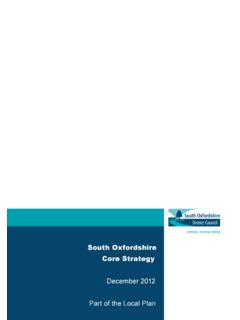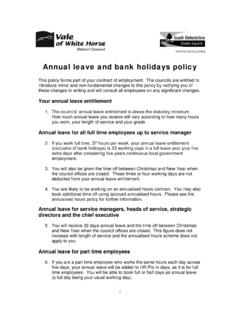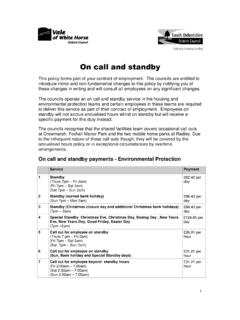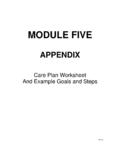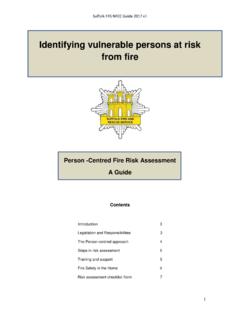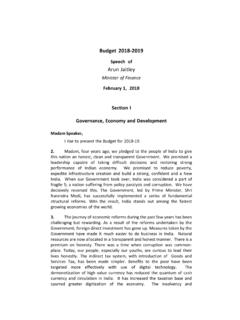Transcription of Extra care and its use class v1 - South Oxfordshire
1 Extra care and its use class (C2/C3) The term ' Extra care accommodation' can be applied to a range of accommodation types intended to meet the needs of the infirm (primarily but not necessarily the elderly). These include 'assisted living', ' Extra ' or 'very sheltered housing', 'close care ', 'continuing care retirement communities' and 'retirement villages'. Typically contracts can be purchased that allow the household to buy in escalating levels of domestic and personal care to suit the changing needs of the occupant(s). There are different approaches to the definition of Extra care accommodation because different definitions are used for different purposes.
2 For example, the purpose of arriving at a definition to determine the allocation of the New Homes Bonus is different to the purpose of arriving at a definition to determine whether there has been a material change in the use of land and buildings. The different definitions can sometimes help to inform the assessment of an individual case, but should not therefore determine the outcome. The definition for the purposes of determining whether a unit would generate an award under the New Homes Bonus, is the same for determining whether it would be subject to council tax. This hinges on whether it is a self-contained unit of accommodation.
3 The same approach is taken to determining whether a new built unit should be included in more general housing numbers (for net supply and house building purposes). However, in borderline cases it is more likely the tax system (and therefore the 'qualification' for the New Homes Bonus) will conclude that a unit is self-contained and is therefore a dwelling. The DCLG definition of self-containment for the purposes of determining whether a unit should be included in more general housing numbers is where all the rooms (including kitchen, bathroom and toilet) in a household's accommodation are behind a single door which only that household can use.
4 The use class (C2/C3) does not in itself determine whether Extra care accommodation should be included in more general housing figures or for council tax / New Homes Bonus purposes. In Development Management there are, broadly, two areas of interest: whether a development should contribute to the provision of affordable housing, and; determining whether a material change in use has occurred that requires planning permission. In assessing whether or not a unit 'counts' for the purpose of determining whether a development should contribute to the provision of affordable housing, the assessment should not be led by an understanding of the factors that are used to inform an assessment of whether there has been a material change in use.
5 Instead, it is more appropriate to consider the factors that help determine whether a unit should be included in more general housing numbers. If the unit qualifies to be counted as part of the more general housing numbers then it should also 'count' towards the number of homes to be used to calculate the required level of affordable housing, and indeed is itself capable of being a unit of affordable housing. That should be the starting point and will usually be the final word on the matter, unless there is sufficient information available on the details of the proposal that would justify a different approach.
6 This is where the consideration of factors relating to the definition of use class can have a role. The Use Classes Order sets out different categories of residential use and makes a distinction between residential institutions ( class C2) and dwellinghouses ( class C3). There is considerable case law (at planning appeals and in the courts) on the definitions of both. There is no government guidance on which use class Extra care housing falls into. It is for the decision maker to decide, depending on the individual circumstances of each case, which class a particular use falls into. In deciding which is the appropriate use class , much will depend on the extent to which the accommodation is self-contained.
7 ODPM Circular 03/2005 (Changes of Use of Buildings and Land, The Town & Country Planning (Use Classes) Order 1987 (as amended) at paragraph 73 says that sheltered housing developments will usually fall within the C3 class . Beyond that, the decision maker has to draw on appeal decisions and some legal cases and the picture is unclear (if not contradictory). The degree to which a housing development is managed by wardens, nurses etc can have a bearing. Development Control Practice (DCP) reports a case from North Devon where the court held that if the occupants were incapable of undertaking the tasks associated with running and living within a dwellinghouse, then the use would be class C2, unless the carers were living there full time so as to form a household with the residents; a situation unlikely to arise with Extra housing.)
8 This indicates that although a unit may initially be occupied as a class C3 house, over time and as the occupants become increasingly dependent on 'outside' assistance to complete basic domestic and personal functions, then the use may change to class C2; this is not necessarily a material change in use requiring planning permission, and indeed is probably unlikely to be. At the time a planning application is to be determined the detailed proposals for the Extra care accommodation can be examined to assess whether the initial use is more likely to be C2 or C3. What happens later once the unit is built and occupied, perhaps for some time, cannot be ascertained at the application stage.
9 However, it should be noted that in a case in West Oxfordshire (also DCP) where the use fell between sheltered housing and a care home, the High Court found that the use was sui generis. Notwithstanding this, in the first instance, unless the details clearly indicate to the contrary, Extra care units that appear to be self-contained units of accommodation should be treated as such and as falling with class C3. As a result, it will be a matter for development management officers to negotiate and determine with the relevant applicants and will be hugely dependent on the individual schemes proposed.
10 It is important to note that we expect CCRCs to include a varying degree of accommodation much of which we will expect be Extra care that accommodates an affordable element. This is supported by OCC. The council will be looking for the majority of units to be C3.
